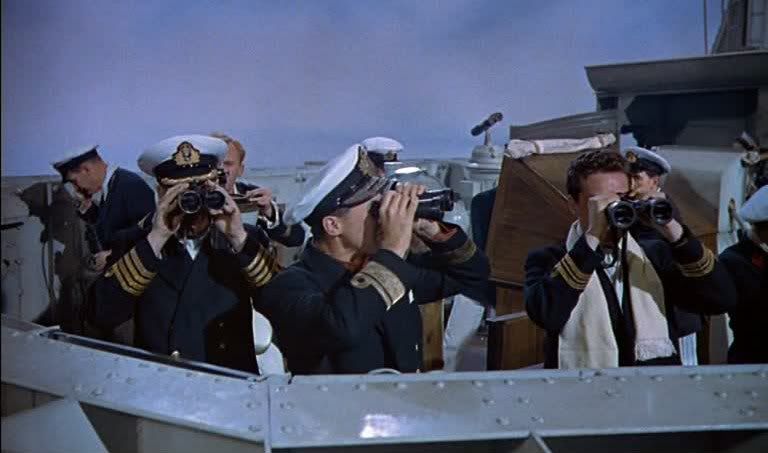
Michael Powell and Emeric Pressburger's The Battle of the River Plate is a scrupulously authentic film about a real World War II battle, in which a trio of British cruisers pursued a German battleship that had been sinking ships along British supply lines. It's a tense, well-crafted war movie that uses real World War II era ships — including at least some of the ships that were actually involved in this encounter — to recreate this intense naval battle and its aftermath along the coast of Uruguay.
The film opens by humanizing the German Captain of the Graf Spee, Langsdorff (Peter Finch), who takes aboard the British Captain Dove (Bernard Lee), the skipper of the Graf Spee's latest victim. The two captains, from opposite sides of the war, nevertheless immediately strike up a gentlemanly repartee based on mutual respect and rivalry. Later, after the battle, Langsdorff expresses awed admiration for the cruisers that had attacked him and sent him into retreat. Seemingly stunned by the way the battle had occurred, he is shocked that the three smaller ships had charged directly at him as though they were much bigger; so great was their bravery, he says, that he was convinced they were actually trying to drive him towards an unseen fleet of much bigger ships, which in fact did not exist. Langsdorff is obviously an honorable man: when, during the post-battle diplomatic negotiations, the propagandistic Nazi reports about the battle are read aloud, Langsdorff paces anxiously back and forth, bristling at this distortion of the battle, which minimizes the bravery of the British sailors and the damage taken by the Graf Spee.
The film is steeped in the value of coolness under fire, valorizing the British officers and sailors who always maintain their gentlemanly reserve and their dry wit in the face of battle and death. The captain of one ship, under heavy fire, is injured in his legs and spends the rest of the battle dispensing commands while a medical orderly applies bandages and stitches to his wounded legs; when the captain notices that the doctor is applying bandages to his left leg as well as his right, he remarks that he hadn't even noticed that both legs were wounded. The same valor is displayed by the lower-ranking sailors as well. When the gunnery station of one ship is blown apart by shells, the wounded and bleeding men struggle to maintain their stations, asking only that doctors are sent down below to tend to them while they prepare to fire again. One of the men, when asked how he is, remarks only that it's "a bit drafty" with all the jagged holes in the hull.

At the height of the battle, Powell and Pressburger cut back and forth between the three British ships and the captured British officers imprisoned in the hold of the Graf Spee. They're in a tough position, cheering on the British navy even though they know that a direct hit on the enemy means their own deaths, that they'll likely go down with the German ship if their own side wins this battle. The heroic sailors cheer on the pursuing British cruisers anyway, speaking as though they're with the British: "we're on their trail," they cheer, even though in fact they're in the heart of the German ship, awaiting destruction at the hands of their own side.
Powell and Pressburger create a moody, potent nighttime atmosphere in scenes of British ships drifting through the night, hunting the Graf Spee with a red-tinged night sky hanging overhead. The nights are eerily quiet, the ships cutting through the water with the dull murmur of their engines and the water lapping at their bows. The images have a sightly unreal magic hour beauty, the red glow in the sky setting the bulky silhouettes of the ships off from the glistening water. Later in the film, Powell and Pressburger's depiction of the harbor of Montevideo, where the Graf Spee takes shelter after the battle, is equally compelling, as the film shifts from the claustrophobic intensity of the naval war sequences to the tense diplomacy and negotiations that take place over the German battleship in this neutral country. The atmosphere of this small harbor, now flooded with journalists, sailors and diplomats, is rowdy and colorful, with much of the action here centered in a small bar where an American reporter (Lionel Murton) sends out breathless dispatches on the struggle over the Graf Spee.
This is a film all about the glory of war, about the nobility of the men who face death so bravely and stoically, whichever side they fight for. It's an almost romantic film, with its depictions of calm battles where no one seems especially ruffled even when men are dying all around them, and images of war ships smoothly gliding through the water beneath dramatically lit skies. The film's climax occurs right at twilight — "the twilight of the gods," one observer in Montevideo remarks dramatically — as the long-awaited showdown between the Graf Spee and the ships amassing to prevent its escape occurs against a blackening sky, the flames of an exploding ship lighting up the night while red and purple hues fill the sky above.
This film was retitled The Pursuit of the Graf Spee stateside. John Schlesinger appears in it in an acting role. His emergence as one of the UKs most important directors was but moments away.
ReplyDeleteYou do a great job framing the film's themes and visual atmospherics. This has always been a rather underestimated Powell and Pressberger film, two often dwarfed by the masterpieces.
ReplyDelete